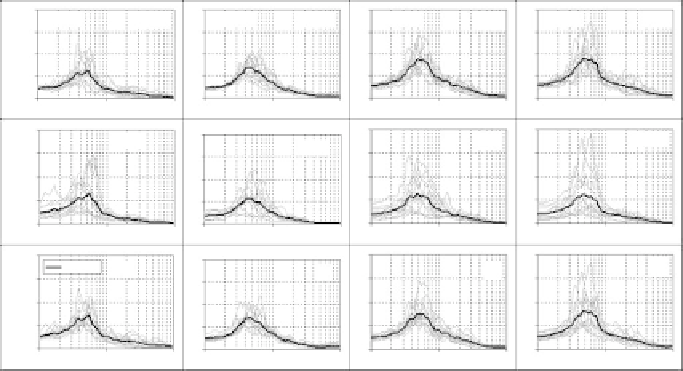Geoscience Reference
In-Depth Information
2
2
1.5
1
0.5
0
2
1.5
1
0.5
0
2
1.5
1
0.5
0
0-10km
PGA
10-20km
PGA
20-30km
PGA
30-40km
PGA
1.5
1
0.5
0
0.1
1
10
0.1
1
10
0.1
1
10
0.1
1
10
2
1.5
1
0.5
2
1.5
1
0.5
2
1.5
2
1.5
1
0.5
PGV
PGV
PGV
PGV
1
0.5
0
0
0
0
0.1
1
10
0.1
1
10
0.1
1
10
0.1
1
10
2
1.5
2
1.5
1
0.5
0
2
1.5
2
1.5
1
0.5
0
AI
average
AI
AI
AI
1
0.5
0
1
0.5
0
1
PERIOD (s)
0.1
1
10
0.1
1
10
0.1
1
10
0.1
10
PERIOD (s)
PERIOD (s)
PERIOD (s)
Fig. 4.1. Elasticacceleration spectra withrespect toscaling scheme and fault distance
and 30-40km (12 records) to evaluate the effect of distance as well as the scaling
scheme. The elastic acceleration response spectra calculated on the ground surface by
site response analysis for the same soil profile for four distance ranges are shown in
Figure 4.1.
The results indicate that the scatter in the calculated amplitudes of elastic acceleration
response spectra is increasing with distance for all scaling schemes. In addition, ampli-
tudes of the average spectra for all three scaling schemes and for four distance ranges
arealsodifferent.AscanbeobservedinFigure4.2,theamplitudesoftheaverageelastic
accelerationspectraareincreasingwithfaultdistanceforPGAandAIscaledrecordsbut
not for PGV scaled records. In general PGA scaling gave the most conservative elastic
acceleration spectraalmost in all cases.
When the results are compared with respect to average spectral accelerations calculated
usingdifferenttimehistoriesrecordedatdifferentdistances,therearedifferencesinPGA
scaled input motions, but there is almost no difference in PGV or AI scaled records.
However,eventhoughaveragespectradonotshowanydistancedependenceforPGVand
AIscaling,thescatterandthechangeintherangeofthecalculatedaccelerationspectrum
shown in Figure 4.1, indicate the importance of the distance as one of the controlling
parameters.
The scatter and range of elastic acceleration response spectra on the ground surface cal-
culatedbysiteresponseanalysesincreasewithdistanceoftherecordedtimehistoriesfor
all scaled input motions. This could lead to different spectral accelerations if the scat-
ter is evaluated by statistical procedure based on a probabilistic approach. Therefore, it
wouldbeessentialtoselecttherealtimehistoriesforsiteresponseanalysisatcompatible
distance range as determined bythe sitespecific hazard study.

